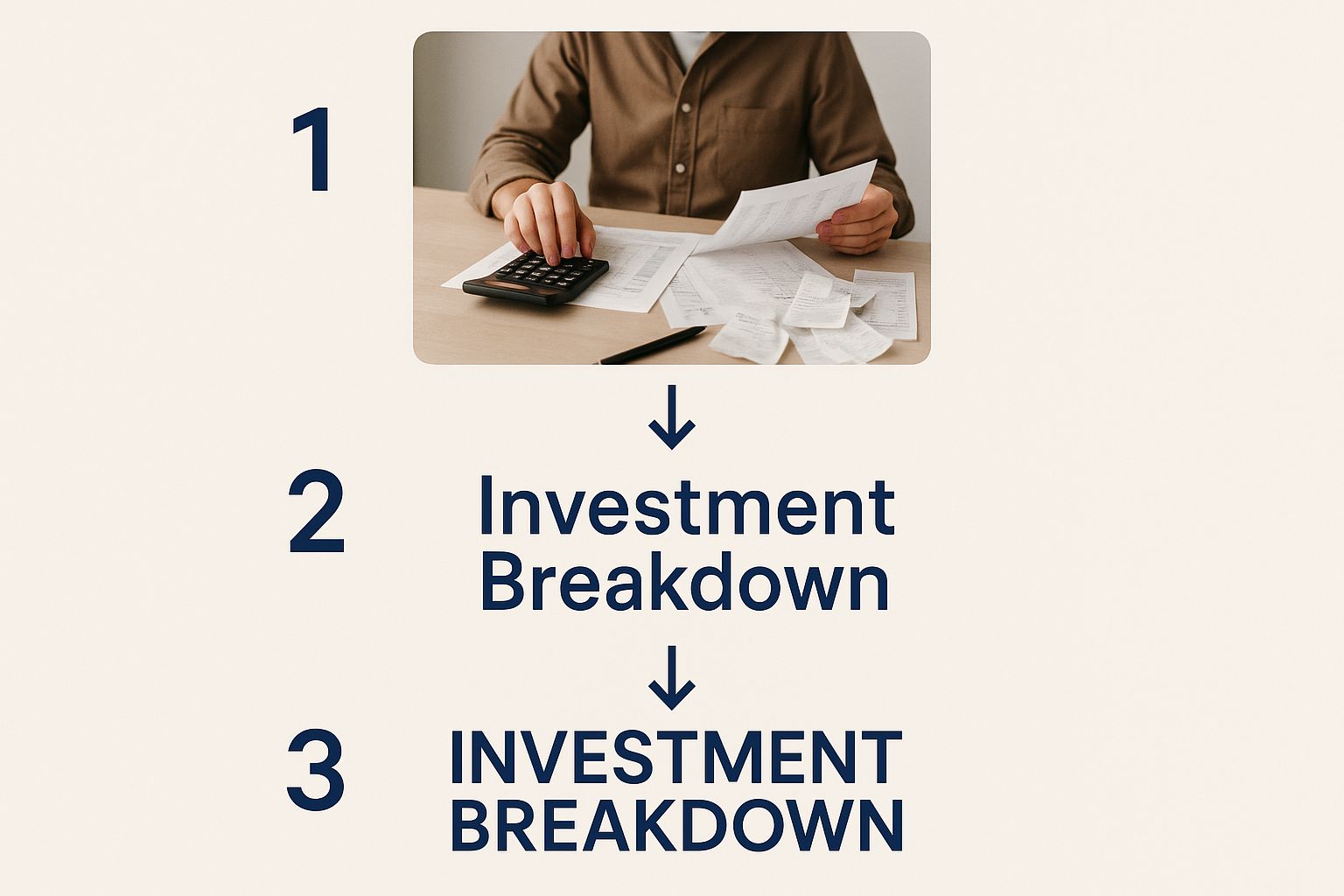Let's be honest—measuring the "return on investment" for your church's social media can feel a bit... corporate. But really, it’s all about connecting your online efforts to real-world ministry growth.
It's about seeing how that Instagram post translated into a first-time guest or how a Facebook event led to more sign-ups for the small group launch. We’re moving past just counting likes and shares and looking for tangible outcomes. The goal is to clearly link your digital activities to measurable ministry results.
Why Your Church Needs to Measure Social Media ROI

For a lot of us in ministry, social media can feel like a digital announcement board. It's a task on the to-do list, but its actual impact feels fuzzy and hard to pin down. When you start measuring ROI, that whole perspective shifts. Suddenly, your church's social media stops being a weekly chore and starts becoming a powerful, intentional engine for outreach.
Thinking about the return on your investment—both in time and money—is simply good stewardship. It helps you get clear answers to critical questions:
- Which posts are actually encouraging people to plan a visit?
- Are our sermon clips leading to deeper conversations, or are they just passive views?
- With our limited time, where should we focus our energy to make the biggest impact for the Kingdom?
Moving Beyond Vanity Metrics
It's so easy to get caught up in "vanity metrics" like follower counts and likes. They feel good, but they don't tell the whole story. While a growing audience is great, the real value is in seeing how your online presence inspires people to take a step.
Knowing your ROI helps you make smarter decisions. It also helps you show your leadership and congregation that the time and effort spent on digital discipleship is truly bearing fruit.
This isn't just a church thing, either. A recent HubSpot State of Marketing Report found that 77% of marketers say proving ROI is more important now than it was just two years ago. It’s a clear sign that connecting digital efforts to real results matters across the board.
Connecting Actions to Outcomes
At its core, measuring church social media ROI is all about tying an online action to a real-world ministry outcome.
Did a family find your church because of a targeted Instagram ad? Did a new volunteer sign up after seeing a post about a service opportunity? Those are the connections that matter. You can learn more by exploring our detailed guide on how to plan and manage your church social media.
By measuring ROI, you transform your social media from a megaphone into a magnet. Instead of just shouting announcements into the digital void, you start drawing people into deeper community and connection with your church.
Thankfully, this process is getting a lot easier with tools built specifically for ministry. For instance, with ChurchSocial.ai, you can turn a single sermon into a full week of content—from AI-generated reels and social posts to blog articles and graphics. This dramatically cuts down your time investment while creating more opportunities for people to connect.
Beyond the tools, understanding the "why" behind your strategy is key. Diving into proven strategies for social media ROI can equip you to drive real, measurable results that line up perfectly with your church's mission.
Setting Ministry Goals You Can Actually Track
Before we can even think about measuring ROI, we have to get brutally honest about what “success” actually looks like for your church’s social media. Let’s be real: vague goals like “grow our online presence” are impossible to measure and a fast track to feeling like you're just spinning your wheels.
Your social media goals need to be directly tied to real, tangible ministry outcomes. What are you really trying to accomplish?
Are you trying to boost registrations for the upcoming youth camp? Get more first-time guests to fill out a "Plan Your Visit" form? Drive more online giving during the end-of-year campaign? These are the kinds of goals that truly matter.
From Social Posts to Real Ministry Impact
Your social media strategy shouldn’t just be about filling a content calendar. It’s a powerful tool that should actively support your church's core mission. This means we have to bridge the gap between what happens online and the results we see in the real world.
The best way I've found to do this is by setting SMART goals: that’s Specific, Measurable, Achievable, Relevant, and Time-bound.
So, instead of a fuzzy goal like, "We want more people at our fall festival," a SMART goal sounds more like this:
"Increase online registrations for our fall festival by 15% over the next six weeks by promoting it through three targeted social media posts and one reel each week."
See the difference? This approach turns your social media from a content-churning machine into a strategic ministry asset. You know exactly what you’re aiming for, how you’ll get there, and how you’ll measure success when you’re done.
From Ministry Objectives to Measurable Social Goals
Translating broad ministry objectives into specific social media goals can be tricky. This table breaks down how to turn those big-picture ideas into something you can actually track and measure for ROI.
By framing your goals this way, you create a direct line between a social media action (like a post) and a ministry result (like a new family in a small group).
Getting Your Goal-Oriented Content Done
This is where a dedicated platform like ChurchSocial.ai makes a massive difference. Its direct integration with church calendars, such as Planning Center, lets you automatically build targeted content around your most important events.
Imagine your fall festival is already on the calendar. ChurchSocial.ai can help you craft a whole content plan laser-focused on driving registrations for that specific event. It connects your day-to-day social activity directly back to that big-picture ministry objective.
And before you can calculate your return, you have to know your investment. This image breaks down all the costs—some obvious, some hidden—that go into your total social media investment.

Tallying up everything from staff time to software subscriptions is the essential first step to getting an accurate ROI on the goals you’ve set.
It's a common struggle in our field. A recent Sprout Social Index showed that while most leaders feel they can explain social media's value, only 30% of marketers are actually confident in measuring ROI. On top of that, 65% of leaders want to see clear proof linking social campaigns to business goals—which is exactly what this goal-setting process delivers.
With a tool like ChurchSocial.ai, you can quickly generate all the content you need for these campaigns. It can create AI-generated reels from your sermons, write social posts from sermon transcripts, and design graphics with simple templates. The simple drag-and-drop calendar makes managing and updating your goal-focused content plan unbelievably simple, saving you precious time and making it that much easier to hit your ministry targets.
Tracking the Metrics That Truly Matter

It’s incredibly easy to get lost in a sea of social media data. You open up your analytics dashboard, see a dozen different charts, and it all starts to feel a bit overwhelming. To really understand your social media ROI, you have to cut through that noise and focus on the numbers that signal real ministry impact.
The trick is learning to tell the difference between vanity metrics and action metrics. Vanity metrics, like your follower count or page likes, look impressive on paper but don't tell you much about genuine connection. Action metrics, on the other hand, tell a story of real engagement and spiritual growth.
Differentiating Vanity from Action
Think of it this way: a high follower count is nice, but if no one is commenting, sharing, or taking that next step, those followers are just a passive audience. Action metrics prove that your content is actually moving people to do something.
Here are the essential key performance indicators (KPIs) your church should be tracking:
- Reach: This tells you how many unique people saw your post. It’s the digital equivalent of how many people walked past your church’s sign on a given day. A growing reach means you're successfully expanding your digital front door.
- Engagement Rate: This is the big one. It combines comments, shares, saves, and reactions to show you what percentage of your audience is actively interacting with your content. High engagement is a sign of a healthy, connected community.
- Conversion Rate: This is where digital meets disciple-making. This metric tracks the percentage of people who take a specific action after seeing your post, like filling out a 'Plan Your Visit' form, signing up for a small group, or clicking a link to your online giving page.
Connecting Metrics to Ministry
Imagine you post a short, powerful clip from Sunday's sermon. Seeing a high share rate on that video isn't just a number—it’s a direct indicator that your congregation was so moved by the message that they’re actively participating in online evangelism, sharing the Gospel with their own networks.
This becomes effortless when you use a tool built specifically for ministry. With the AI reel generator in ChurchSocial.ai, you can instantly create compelling, shareable clips directly from your sermon transcript. This capability powerfully connects a digital metric (shares) to a profound spiritual outcome (evangelism).
When you focus on action-oriented metrics, you stop asking, "How many people saw our post?" and start asking, "How many people were moved by our post?" This shift changes everything about how you measure social media success.
For example, instead of just celebrating a post that got 200 likes, you can celebrate the post that led to three families registering for the new members' class. That’s a measurable return that church leadership can truly understand and get behind.
If you're looking for more ways to define what success looks like for your church, check out our guide on how to measure social media success for deeper insights.
A Simple Formula for Calculating Church ROI
Figuring out your social media ROI doesn't mean you need a finance degree. The formula itself is surprisingly simple, and you can adapt it to any ministry context to see the real-world impact your online efforts are making.
At its core, the math looks like this: (Return - Investment) / Investment x 100
This little equation spits out a percentage that tells you how you're doing. A positive number? Awesome, your efforts are generating more value than they cost. A negative number? That’s a sign you’re investing more than you’re getting back.
For churches, the real work isn't the math—it's figuring out what 'Return' and 'Investment' actually mean for ministry growth.
Defining Your Ministry Investment
Your "investment" isn't just the cash you spend on Facebook ads. To get the full picture, you need to tally up all the resources you're pouring in.
- Financial Costs: This is the straightforward stuff. Think subscriptions for tools like ChurchSocial.ai, ad spend, or any stock photos you buy.
- Time Costs: This is your most valuable asset, and it's so easy to overlook. Track the hours your team or volunteers spend brainstorming, creating, and scheduling posts. Then, assign a reasonable hourly rate to that time to give it a real-world cost.
Using a platform like ChurchSocial.ai can dramatically cut down that time investment. When it generates a full week of social posts, blogs, and even AI-powered reels from a single sermon, you're getting dozens of hours back every month. That efficiency directly lowers the "Investment" side of your ROI calculation.
Assigning Value to Your Ministry Return
This is where it gets really powerful for churches. Your "return" isn't just about dollars and cents; it’s about discipleship, connection, and community growth. The key is to assign a tangible value to the non-monetary wins that fuel your mission.
For example, what's the value of a new family joining your church? Or a new volunteer signing up for the kids' ministry? These outcomes are incredibly valuable, and assigning even a conservative monetary equivalent helps you quantify your return in a way that makes sense.
Businesses do this all the time when they evaluate customer lifetime value. For a deeper dive into these concepts, this guide on calculating financial value has some great insights. Applying this kind of thinking helps justify the time and resources you put into creating great content that actually grows your church family.
And this isn't just theory. Globally, social media ad spending has soared to $276.7 billion, with an average ROI hitting 250%. That means for every $1 spent, businesses are seeing $2.50 in return. It just goes to show how powerful a well-thought-out strategy can be.
Using the Right Tools to Streamline Measurement
Let's be honest. Trying to track your social media metrics by jumping between Facebook Insights, Instagram Analytics, and YouTube Studio is a fast track to burnout. For anyone on a church staff, stitching together a clear picture from a dozen different dashboards isn't just inefficient—it's completely unsustainable.
This is where having an integrated, all-in-one tool becomes a total game-changer.
Instead of wrestling with clunky spreadsheets and a sea of browser tabs, a central hub like ChurchSocial.ai pulls all your important data into one spot. You can see what’s working and what isn’t at a glance, turning measurement from a dreaded monthly chore into a simple part of your weekly rhythm.
Think about it: your biggest investment is often your time. The less time you spend chasing down data, the more you can pour into creating content that actually connects with people and helps your ministry grow.
Reduce Investment with AI-Powered Content Creation
One of the biggest variables in your ROI equation is the "Investment" side of things—specifically, the sheer number of hours your team sinks into making content. This is where the right platform can make a huge difference.
Imagine turning a single Sunday sermon into a whole week's worth of high-quality social media content.
With ChurchSocial.ai, that's not just a dream; it’s your new reality. The platform's AI can take a sermon transcript and instantly spin it into:
- Engaging Social Posts: Ready-to-go discussion questions, key takeaways, and powerful quotes.
- Shareable AI Reels: Short, dynamic video clips that highlight the best moments from the message.
- Blog Articles: Deeper dives into the sermon topic you can post right on your church website.
This feature radically slashes your time investment. Instead of grinding out 10-15 hours a week creating content from scratch, you can generate a diverse content calendar in a fraction of the time. That has a direct, positive impact on the "return" you're getting from your social media efforts. When you're thinking through your strategy, it's worth exploring how to create leverage with automation without losing that crucial human element.
Manage and Execute Your Strategy Effortlessly
A great tool isn't just about measuring results; it's about making execution easier. It’s one thing to have a plan, but it's another thing entirely to consistently post high-quality, on-brand content. This is where so many churches lose steam.
Here's a quick look at how a unified platform like ChurchSocial.ai helps you pull off a professional strategy without the headache.
The dashboard gives you a simple, drag-and-drop calendar that even integrates with Planning Center and other church calendars. This makes scheduling posts for all your events incredibly simple.
The platform also comes packed with a library of professional graphic templates and a super intuitive editor. This empowers volunteers or staff—even those with zero design experience—to create and post beautiful photos and carousels that look amazing. If you're looking to simplify your workflow even more, check out our guide on the top social media tools for churches.
By managing your content creation, scheduling, and analytics all in one place, you create a seamless workflow. This integration means the data you need for ROI analysis is always at your fingertips, making measurement a natural outcome of your daily work, not a separate, painful chore.
Common Questions About Church Social Media ROI
It’s easy to get tangled up in questions about social media ROI, especially when you’re doing ministry. After all, the "return" we're looking for isn't just dollars and cents. Let's walk through a few of the most common questions I hear from church leaders, so you can move forward with a clear plan.
How Can a Small Church with No Budget Measure ROI?
When you don't have an ad budget, your most valuable asset becomes your time. That's your primary investment. So, the "return" you're measuring is all about the real-world actions and connections your content sparks.
Instead of dollars, you’re tracking returns like:
- New sign-ups for your weekly email that came from the link in your bio.
- RSVPs to that potluck you promoted on your Facebook page.
- Direct messages from people in your community asking for prayer or information.
The value isn't monetary—it's the start of a relationship. This is precisely why tools like ChurchSocial.ai are such a game-changer. It helps you maximize that time investment. By turning a single sermon into a week's worth of posts, blogs, and reels, you multiply your potential for connection without adding more hours to your already packed schedule.
What Is a Good Social Media ROI for a Church?
For a church, a "good" social media ROI isn't a magic number or a specific percentage. It's much simpler: are you achieving your ministry goals?
Success is measured by spiritual and community impact. If your goal was to get 20 people to join a new small group, and you got 25 sign-ups exclusively from your social media efforts, that’s a fantastic ROI. You hit your goal and then some.
Focus on positive trends over time. Is your engagement rate climbing? Are more people taking that next step to visit your website or join a group? That steady growth is your true return. It shows that your social media is an active, contributing part of your church's mission.
How Often Should We Track and Report Our ROI?
You need to stay on top of your performance, but you don't want to get lost in a sea of data. A monthly review is the perfect rhythm. It’s often enough to spot what's working and adjust your strategy, but not so frequent that you feel overwhelmed.
I usually recommend a quick, informal check-in each week on key metrics like engagement and reach. But save the deeper ROI analysis for a simple monthly report. And it doesn't need to be a 10-page thesis.
A one-page summary for your leadership team is often more than enough. Highlight the big wins—"Our Easter service posts reached 5,000 local residents"—and connect the dots for them, showing how your work is directly supporting the church's mission.
With the simple drag-and-drop calendar and built-in analytics inside ChurchSocial.ai, pulling this data together becomes a quick part of your workflow, not a monthly headache.
Ready to stop guessing and start measuring what truly matters? ChurchSocial.ai gives you the tools to turn one sermon into a week of impactful content, manage your entire strategy from one simple calendar, and see the real-world results of your online ministry.




